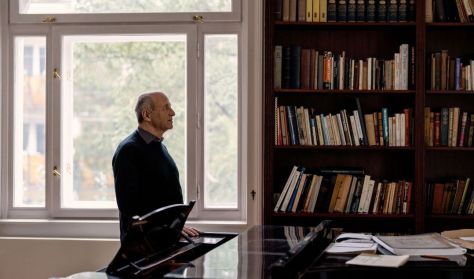
Orchestral concert: Mahler
Mahler
Richter
Karg
Fischer

Mahler
Richter
Karg
Fischer
Ön egy múltbeli eseményre keresett rá. Kérjük, válogasson aktuális kínálatunkból a Jegy.hu keresőjében!
Last event date: Thursday, May 08 2025 7:45PM
May
6–7–8
Müpa Budapest, Béla Bartók National Concert Hall
Tuesday 6th
Wednesday 7th
Thursday 8th
Gustav Mahler: Symphony No. 2 in C minor (“Resurrection”)
Anna Lucia Richter (mezzo soprano)
Christiane Karg (soprano)
Hungarian National Choir (choir director: Csaba Somos)
conductor: Iván Fischer
Iván Fischer has made it a point to look after Gustav Mahler’s symphonic oeuvre: accordingly, not a season goes by without the BFO performing at least one piece by Mahler. Following Symphony No. 5, on the program in January, the last concert in Müpa Budapest of the season will feature Mahler’s monumental Symphony No. 2. This performance of the piece known as the “Resurrection” will feature the Hungarian National Choir, one of the country’s leading professional ensembles, as well as two outstanding guest soloists. Her “voice has a warm, sensuous sound that is multi-dimensional, without heaviness, and has impressively effortless breath control,” a BBC Music Magazine critic has said of Anna Lucia Richter. Christiane Karg is a return visitor at the Mozarteum in Salzburg, the Musikverein and the Theater an der Wien in Vienna, Covent Garden, and La Scala in Milan. She performed the same piece with the Budapest Festival Orchestra in 2020.
No sooner did Mahler finish composing his Symphony No. 1, entitled “Titan,” than he got to work sketching out his next piece. Although he completed the first movement in September 1888, his appointment to lead the Budapest Opera and a number of deaths in his family interrupted his creative process. Giving up on continuing his project, Mahler intended to publish the piece as a stand-alone symphonic poem, entitled Funeral Rites. The title was a reference to the funeral mass of the hero of his Symphony No. 1 – the origins of Mahler’s resurrection story. Thus, the “Resurrection” symphony, instead of describing the well-known Easter events, actually tells the audience about how each person’s soul is eternal, and eventually, all lives continue in another body.
The first movement was finally completed in 1894; in the meantime, in 1891, Mahler composed the three middle movements of the piece in just a matter of a few weeks. The opening movement (like the final two) are characterized by equal parts, complicated editing principles and a complex harmonic world and instrumentation similar to Wagner’s works. Compared to this, the second movement is based on the popular music of Mahler’s time and his recent past (as is the third), employing clean harmonies and instruments either accompanying or playing the melody. As the composer said, the second movement is a “happy moment” in the life of the hero buried in the first: “a painful memory of youth and innocence.” The second movement is so different from the first in terms of musical language that Mahler called for an intermission of five minutes between the two.
The idyllic atmosphere reminiscent of the southern German and Austrian dance the ländler is interrupted by the brutal entrance of the timpani in the scherzo. The music of the movement is almost identical to a song Mahler had composed earlier almost as a test, entitled Saint Anthony of Padua’s Sermon to the Fish. The pulsing of the ländler later turns into a klezmer, while the members of the audience feel as though they were “watching a dance from a distance through a window, without being able to hear the music.”
The heartrending slow movement is entitled Primal Light. Like an oracle, the soloist singer tells us where we come from and where we are headed in life. The singer sings to the red rose, moving on the boundary between music and text, and thereby presenting a transition between life and death, between unredeemedness and redemption, as well as – being a vocal section – between the primarily instrumental symphony and what lies beyond the symphony.
Like the first movement, the finale was also composed in 1894. Mahler heard Friedrich Klopstock’s ode Resurrection performed by a children’s choir at the funeral of his musical father figure, Hans von Bülow. It was then that he went to work on the final movement of his symphony, calling it Resurrection. It sets Klopstock’s two stanzas and additional verses of his own to music. Brass winds performing behind the scenes, a choir, an organ, bells and dies irae – an incredible ending.
Szente Vajk ezúttal is gondoskodott róla, hogy egy felhőtlen estét tölthessünk együtt a Játékszínben!
Sherlock Holmes megint szemben találja magát az ördögi Moriarty professzorral. Bohémia királyát egy nemzetközi kémkalandban valakik megzsarolják. Sherlock Holmesnak ezügyben válogatott bűneseteket kell megoldania, tét a világbéke – és közben még egy amerikai színésznő, Irene személyében a szerelem is ráköszön…
Dumaszínház est
Dr. Schwab Richárd előadása: Emésztőszervi funkcionális betegségek és a mikrobiom / Táplálkozás - emésztés - egészség
A Csokonai Nemzeti Színház Debrecen vendégjátéka BEMUTATÓ: 2025. március 7. ELŐADÁSOK: 2026. július 31., augusztus 01. tervezett esőnapok: 2026. augusztus…
item(s) in basket
total:
Time limit has expired. Please, put item(s) in to basket again.